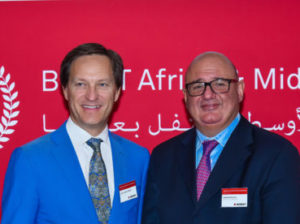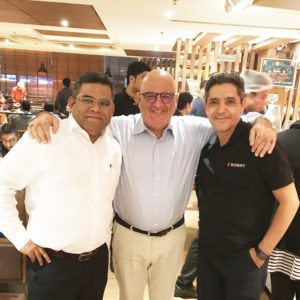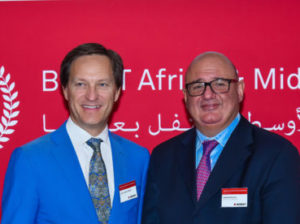A hundred-year legacy of making converting machines, and yet, evolving, Samir Khoudja, managing director for Africa and Middle East for Bobst tells Benjamin Daniel, editor of Packaging MEA, about the ways of his company

Samir Khoudja, Managing Director of Bobst Africa & Middle East
Celebrating the 25th anniversary of its BOBST Africa and Middle East
It seems the business of packaging converting is becoming more and more elaborate. One manifestation of this is the continued global success of Bobst, the packaging converting machine manufacturer for segments across the packaging industry.
In 2018, Bobst reported an annual turnover of CHF 1.63-billion, more than 1,400 machines sold world over, and more than 5,600 employees across the globe.
Cut to the Middle East and Africa region
When it started its opera- tions here in this region, it had engaged two or three people, but now there are over 100. The annual turno- ver of the region was not more than 2% of the global figures. But today it’s 10%. “We hope to continue the moment in times to come,” says Samir Khoudja, the managing director for Bobst in Africa and the Middle East.
Bobst was present at the recently concluded ArabPlast 2019, and though “there was a much lesser footfall in terms of people, but the quality of sale is better as more professional people are coming” feels Khoudja. That’s because there are more and more people coming here from African countries such as Kenya, Nigeria. “These countries are trying to develop an industry over there,” says Khoudja. “Take, for example, Ethiopia.
Until now that country was not producing any packaging. Now they are, and for the time being, it is a niche market when compared to countries such as Saudi Arabia or UAE among others.”
Training a key
Bobst machines don’t come cheap but are the ‘to have’ kit when one has the power to invest in it. But it’s how you run it become critical. How? Say, a Bobst die- cutting machine running at a plant is run at a speed of 5,000 sheets per hour when it is capable of operating at a speed of 9,000 sheets per hour. “You are underutilising the machine. This difference in speeds of running the machine can be huge when it comes to productivity and returns,” says Khoudja?
To improve productivity and thereby return on investment, customers need to have trained and skilled employees. Bobst has been providing training to the operators, as part of its after-sales service and contribution to the packaging converters.
Khoudja cites Bobst’s Pune operation. “Initially we planned to export human resources from India to other countries, in reality, most of them are needed there as India is a huge business and the business is growing there.”
In countries like Saudi Arabia, Bobst has trained and is training the opera- tors. “But, we realised that they leave the company or country and then you need to train new or alternative resources all over again. So this is a never-ending story,” laments Khoudja.
Smart packaging?
Bobst has continued its quest for innovation and excellence. Our progress is not limited to just manu- facturing but the entire conversion process and its optimisation. “Remember, we are in the packaging industry and not in the food processing where the process is somewhat easy and repetitive,” states Khoudja.
3 Examples from Khoudja
- As for our current and future regional mission with machinery, we will further look at the potential with our Expertfold folder-gluer with focus on the inline quality control Accucheck 2 and the patented device Speedwave.
- “The Accucheck delivers zero-defect cartons, while the Speedwave increases productivity for crash-lock bottom jobs. It’s a perfect fit for converters who are seeking to automate production and assure quality and ultimately increase profit,” says Khoujah.
- In the corrugated segment, there’s the MasterFlex-HD flexographic post-press kit, which is used to produce numerous items of packaging and displays that previously required offset printing. Khoudja claims that there is still no national or international standards in place to govern flexo post-printing, yet there are examples of customers saving cost on plates. “For large-sized printing plates, they cost around €500 per square meter. He says, these days no one can afford to have to re-make plate sets from scratch again due to incorrect or missing specifications,” Khoudja explains.
In the flexographic space, there’s the 20SIX CI flexo press, which can take on a wide range of flexible pack- aging printing jobs. “Among the technical highlights of the presses is also the SmartGPS off-press set-up system. This system not only reduces the amount of waste during set-up next to zero but also serves as a quality control instrument for printing hardware and plate mounting,” informs Khoudja.

Segment growth dilemma
Flexible packaging, both rotogravure and flexo are growing. But why is the sector growing? It’s the quality, the ability to produce and export.
Khoudja says, “Today we are running rotogravure and flexo presses with 10-colour units. As for the substrate, they are easy to export given the lightness of the substrate. You can fill a complete container of 10,000 million square meters, which you cannot do with corrugation-based packaging.”
Within the flexible packaging industry, there is a concern over cost, which Bobst is trying to address. Bobst Manchester has developed solutions for reducing the cost of packag- ing. “We have our vacuum coaters and metallisers, which are characterised by minimal downtime and superb quality produced at high speeds. Top suppliers of vacuum coating and metallising solutions for barrier, decorative, security and high-technology appli-cation use these solutions.” By reducing the number of layers, you reduce the glue and other materials.
Flexible packaging is an important market and is mostly used in food packaging. Consumers are becoming more conservative. We no longer see consumers buying five kg of detergent boxes. Today it is in smaller boxes of 200gms. It’s not because the consumer cannot afford it, but because the consumer just does not want to produce waste. Khoudja philosophises, “Waste is not in raw material, waste is everything in our life.”
One platter packaging solutions
Bobst as a Group is offering solutions from labeling to flexibles to cartons to corrugation.
“The strategy is very simple. We believe Africa as a strong potential, and we are preparing. We have opened an office in Nigeria, and now we need to hire people, without people we can’t do anything. We need to now keep a watch over the Gulf area and Africa. We believe both are linked and therefore, we need a global strategy. At the same time, a dedicated approach is imperative as the requirement in Africa today is completely different from this area,” says Khoudja,
“We do believe in a consolidated image or picture. This scenario will grow, and I can tell you the growth in this area is much more than the growth in Europe. Usually in this area the competition especially from China it is easy for them to attack this area than Europe. One more reason to be prepared and have the right weapons, be smart and keep an eye over the area or you will lose.”
Are small manufacturing players competing with Bobst, a challenge?
I would say, some customers, especially the ones who have the power to invest will buy a Bobst machine. On the other hand, those who have no experience or do not have the finance, will start with our competitors’ equipment and their next investment most probably will be a Bobst machine, says Khoudja.
For Bobst it makes sense. There are two reasons: One, a new entrant may not have the experience to run Bobst and perhaps does not want to take a risk. Second, has to do with Bobst. “We do not push our machine at inexperienced converters and disturb the market. We sell machines, but the main strategy of Bobst is to think of the future; build strong players in the converting space.
Khoudja sums up, “There’s an Egyptian saying, the sun shines for everyone but not at the same time. Our vision is clear. Think about the long term, try to not lose money.”



